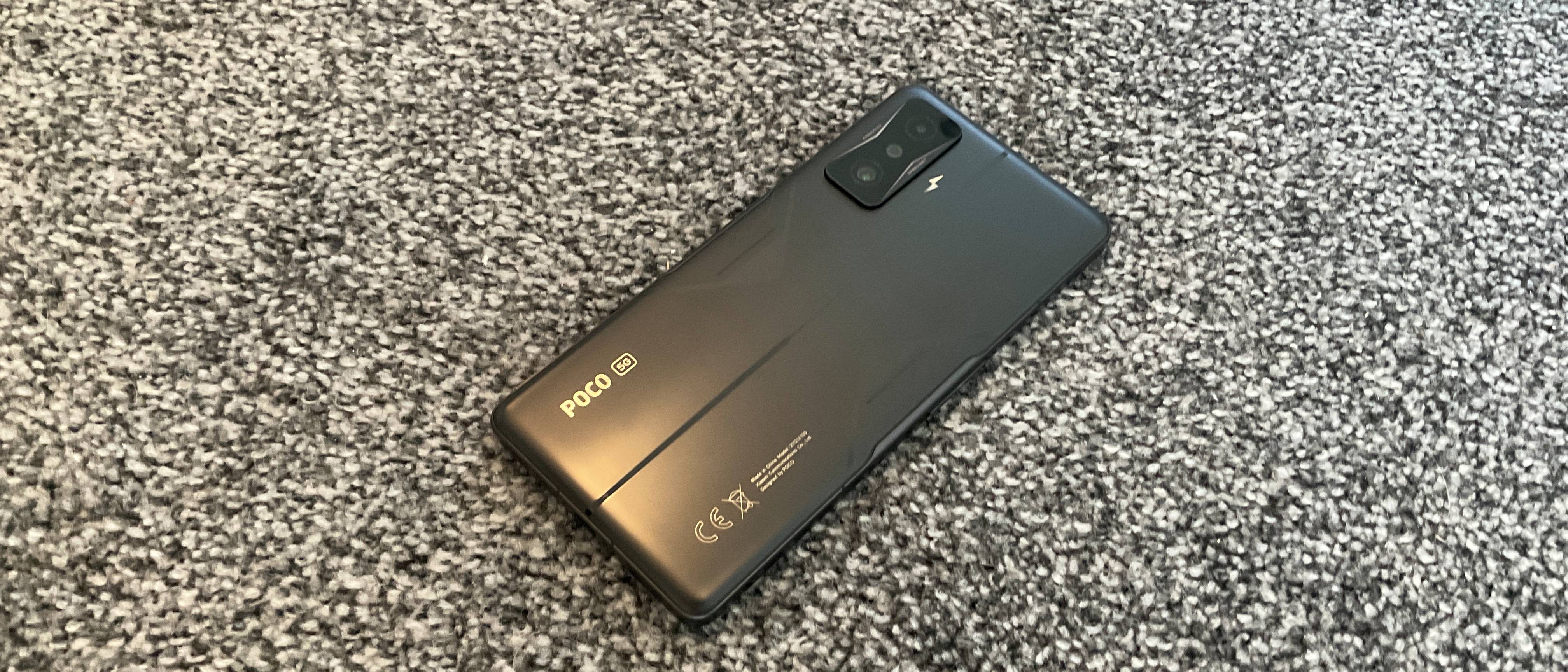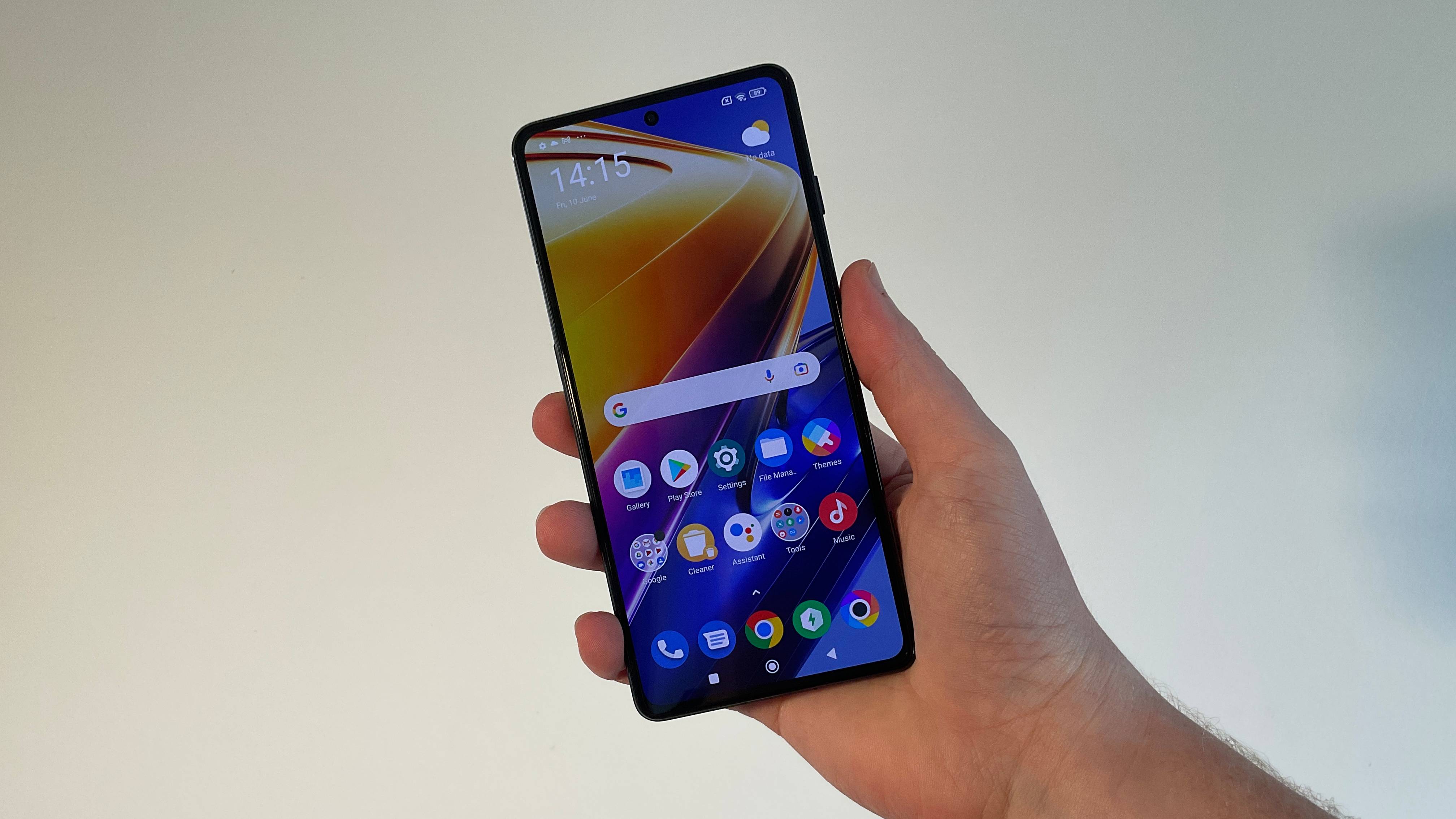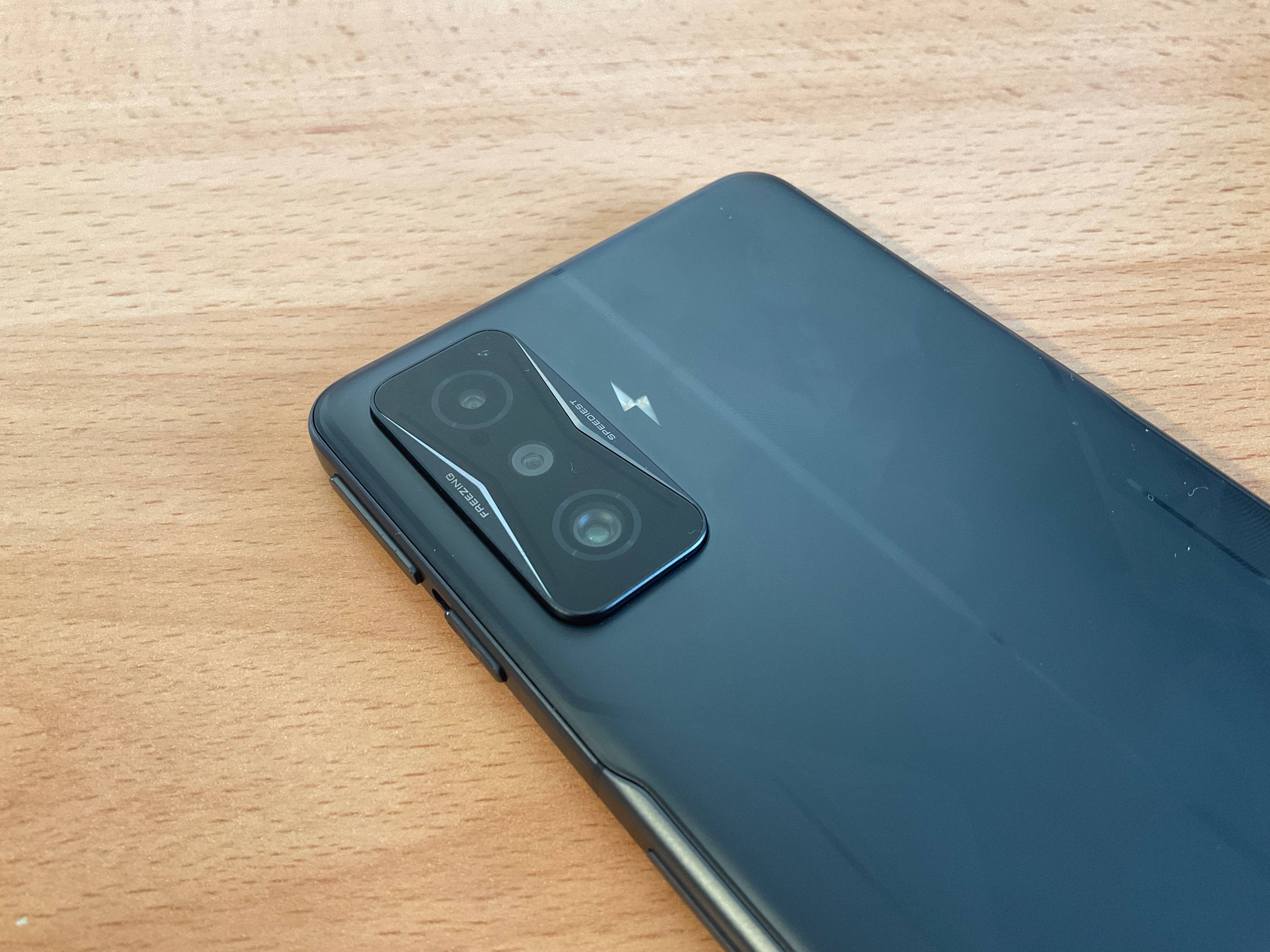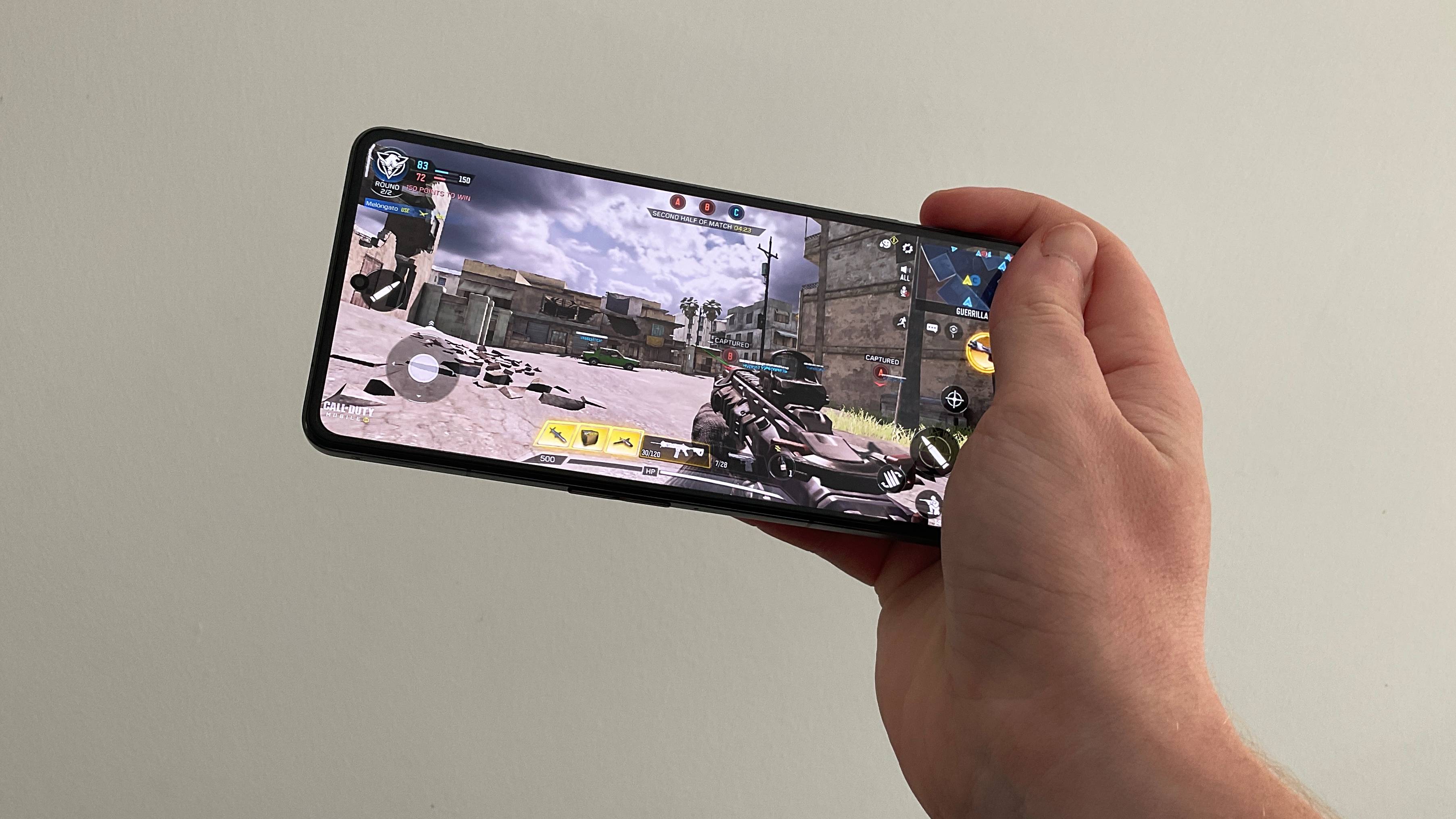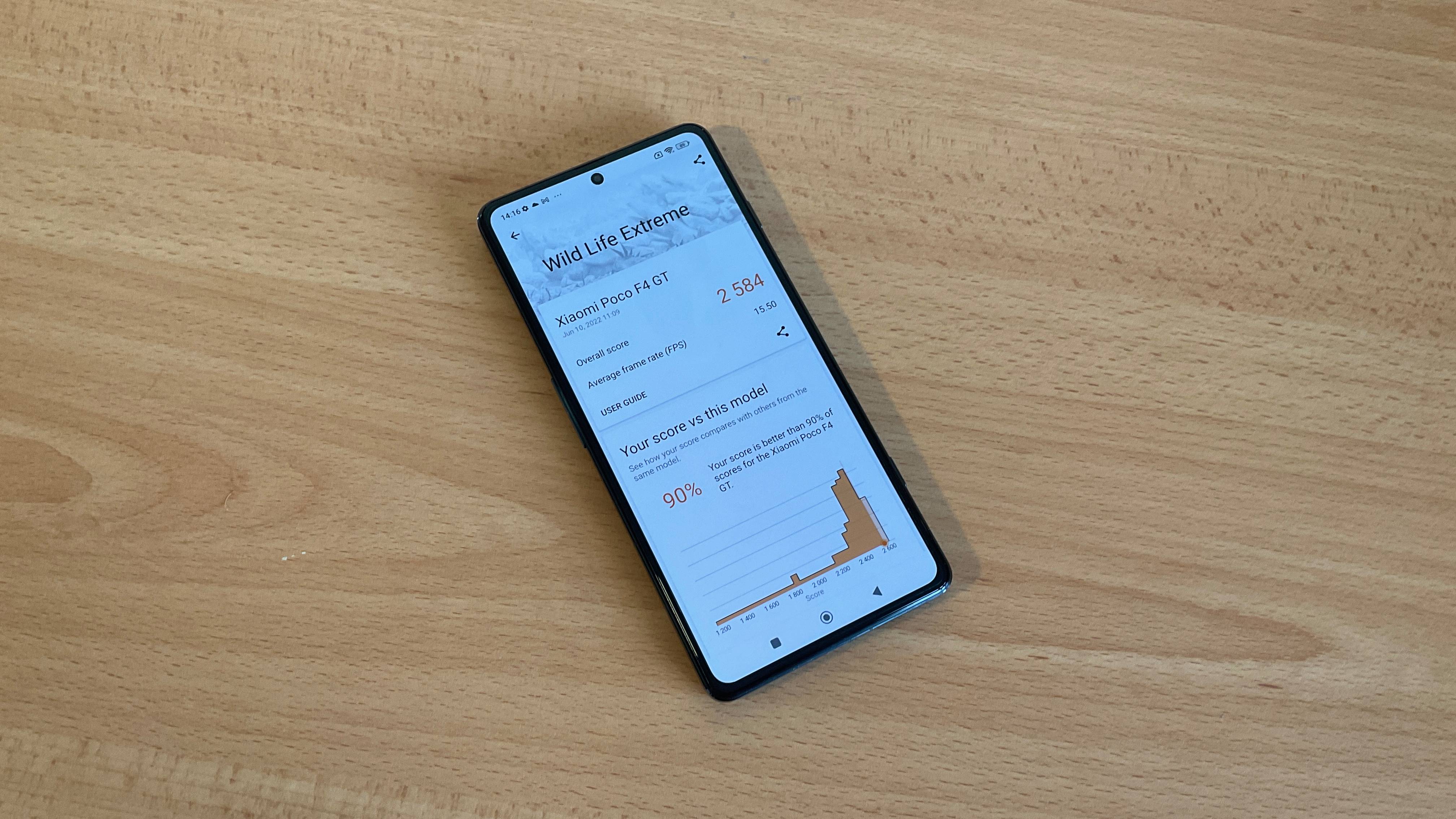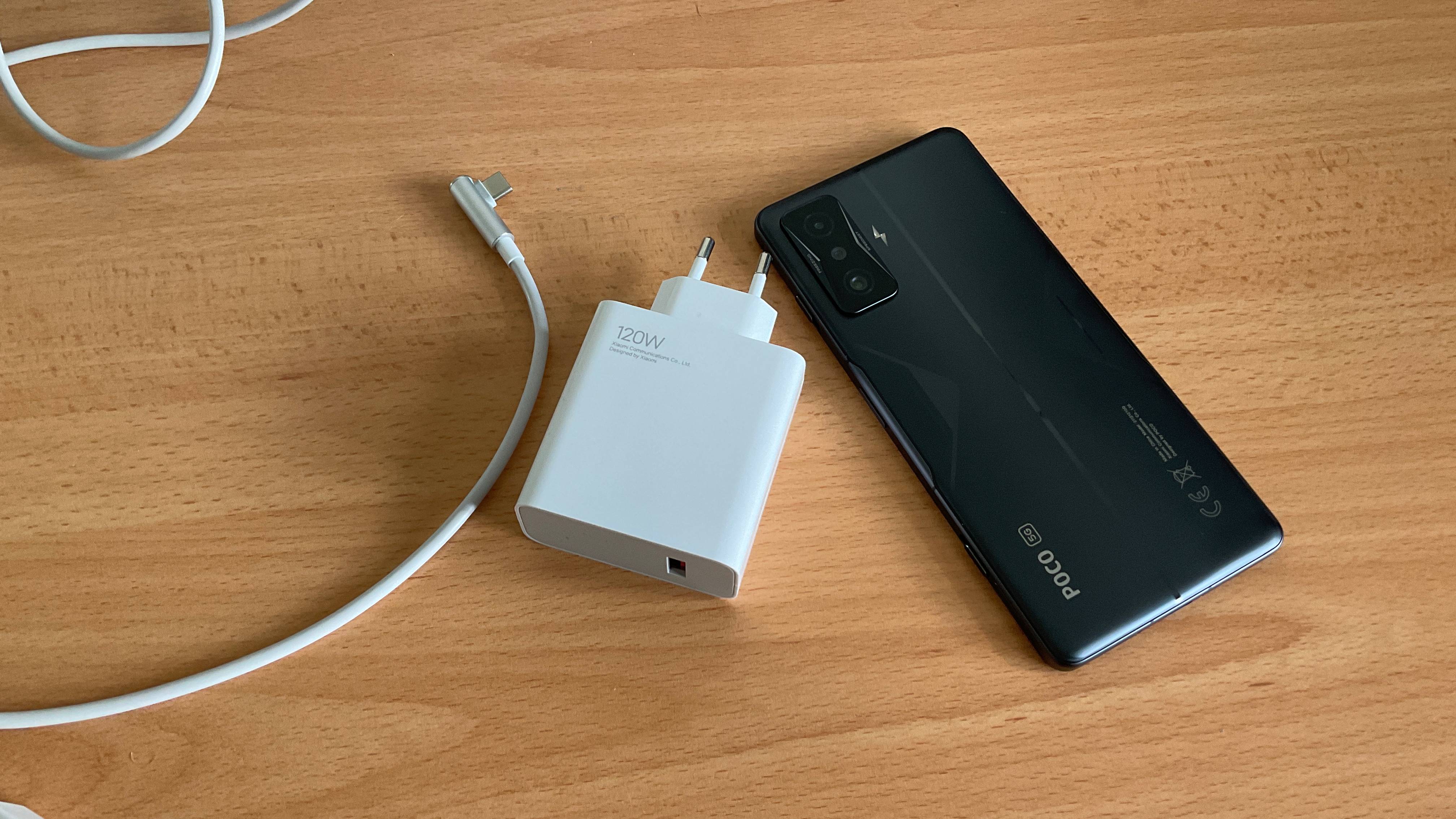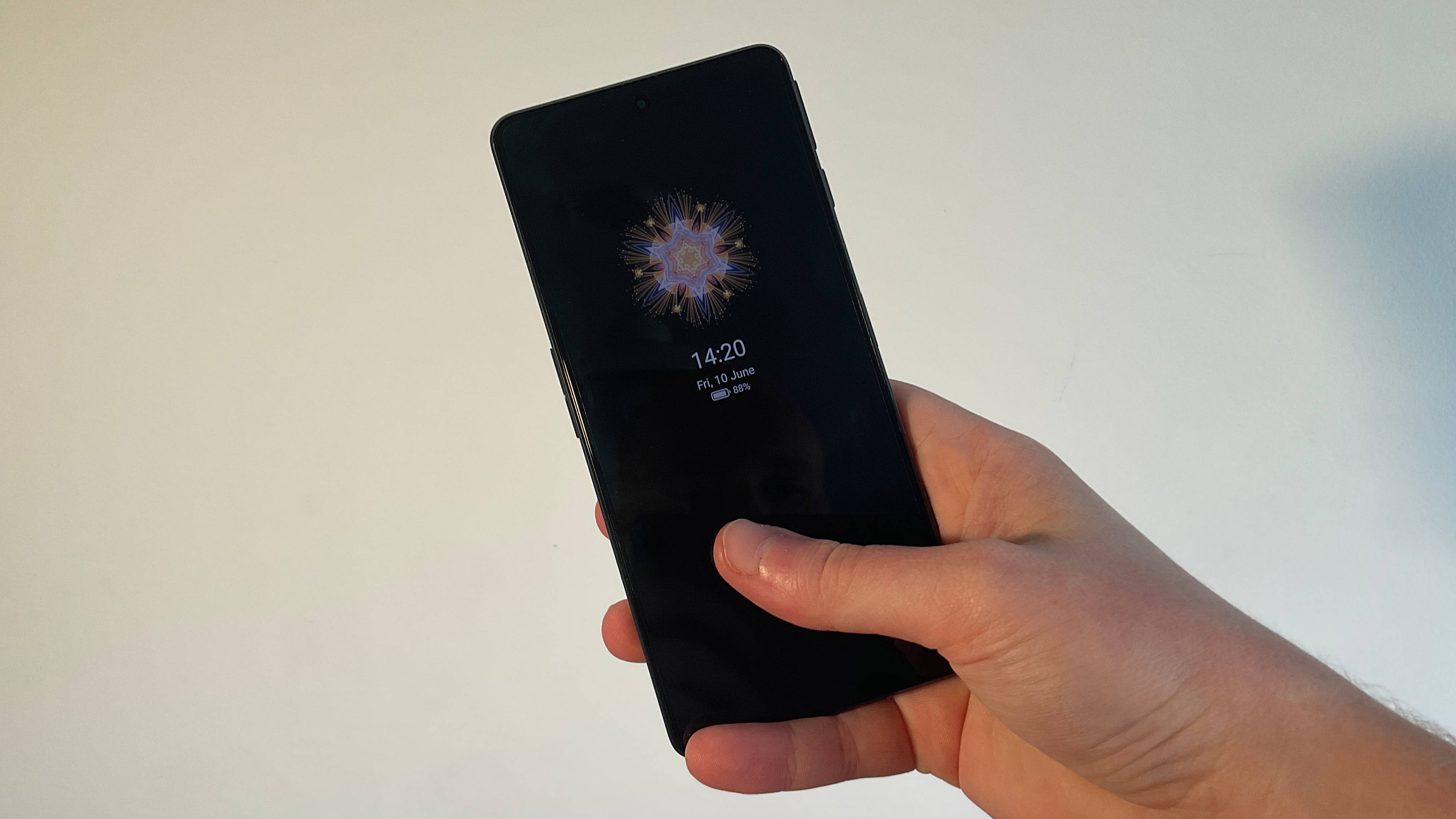Laptop Mag Verdict
The Poco F4 GT strives to deliver top-of-the-line specs with its Snapdragon 8 Gen 1 processor, 120W charging and gorgeous 120Hz AMOLED display, and for the most part, it achieves its goals as an “Apex Flagship” for gamers.
Pros
- +
Powerful Snapdragon 8 Gen 1 processor
- +
Fantastic magnetic pop-up triggers
- +
Excellent 120Hz AMOLED display
- +
120W charging
- +
Snappy fingerprint sensor
Cons
- -
MIUI holds it back
- -
Middling battery life
- -
Average camera performance
Why you can trust Laptop Mag
Xiaomi continues to reach new heights with its sub-brand smartphone offerings; it’s latest achievement is the Poco F4 GT. Why does this phone particularly stand out? Well, it’s a mid-range smartphone with a flagship Snapdragon 8 Gen 1 slotted in. That’s an impressive feat for an Android phone that costs just £699. Couple in its 120W charging speeds and 120Hz AMOLED display, and you’ve got a bonafide flagship killer.
With these highlighted specs, it would be right to think Poco is trying to edge its way into the casual smartphone user market. However, this is more of a phone for gamers, thanks to its game-boosting software and magnetic triggers. Even better, it doesn’t exactly look like a gaming phone. I don’t know about you, but that’s a huge plus for someone who likes to game on their phone without its design being purely focussed on the fact it has gaming-centric capabilities.
While it excels in some areas, it won’t sway people from sticking with more popular smartphone brands. Does it reach the heights of the “Apex Flagship” it’s claimed to be? Let’s find out.
Poco F4 GT price and configurations
The Poco F4 GT just makes the cut for the mid-range phone category, priced at £699 (around $827). That’s a competitively priced phone considering the Snapdragon 8 Gen 1 it houses, along with the 120Hz AMOLED display, 12GB of DDR5 RAM and 256GB of storage.
Sure it’s a little more expensive than the £599 Realme GT Neo 3 150W,however, you’re getting more gamer-friendly features with the pop-up shoulder buttons and sleek design. The $799 Samsung Galaxy S22 and $999 Xiaomi 12 Pro (I believe the price difference would make out the Poco F4 GT to be around the same price as the Galaxy S22 if Poco sold its phone in the US, if not less) are true flagship options, but the F4 GT mostly holds it own the in terms of specs, although not so much in the camera department.
The F4 GT is available right now in the UK. As for the US, like the Poco X4 Pro 5G, availability is a bit of an open question.
Poco F4 GT design
Gaming phones are often plagued with mortifying designs that scream “I’m a gamer!”, which isn’t appealing for a majority of smartphone users — even if they like to dabble in some Call of Duty: Mobile. Thankfully, that’s not the case for the Poco F4 GT.
Poco has gone with a more subtle design, standing out as a phone that can be used for casual, everyday tasks while still hinting at its gaming capabilities. It comes in three colours: Stealth Black, Knight Silver, and Cyber Yellow. That last one looks like it was pulled straight from Cyberpunk 2077 marketing, but the other two have a more discrete, slick design.
We received the black model with subtle laminated lines on its plastic back cover, giving it a futuristic “gamerfied” appeal. Its hourglass-shaped camera bump holds three camera lenses placed vertically with a lightning icon next to it. The camera bump also has “FREEZING SPEEDIEST” on either side. What does that mean? I don’t have a clue.
Xiaomi is unmatched when it comes to its fingerprint sensors; it instantly recognizes biometrics to unlock the phone in a flash. Like the Redmi Note 11 Pro, the Poco F4 GT is equipped with a fingerprint sensor embedded in the power button. It’s ideally placed on the side, making it easy for me to put my thumb on the button and unlock it without a second thought (or having to look at the screen). The recognition is super snappy, and makes me realize how annoying Touch ID is on my iPhone SE (2020).
On either side of the power button are the magnetic triggers and switches to pop them out. While it seems like one too many buttons, the sliders subtly blend into the side of the phone so they aren’t so obtrusive. I’m also a fan of how the triggers feel, and they are well placed, so they are easily reachable when gaming. Although, I would sometimes slip a switch when putting the phone into my pocket.
Other than that, the F4 GT has a near-bezeless display with a small hole-punch camera placed at the top-centre. With dimensions of 6.3 x 3.3 x 0.33 inches and weighing 7.4 ounces, the Pocois quite the chunky device compared to the Xiaomi 12 Pro (6.4 x 2.94 x 0.32, 7.23 ounces), Realme GT Neo 3 (6.4 x 2.9 x 0.3 inches, 6.4 ounces), and Samsung Galaxy S22 (5.75 x 2.8 x 0.3 inches, 5.9 ounces). But, as a phone meant for gaming, the size and weight are actually ideal for gaming sessions, and feels premium when using it for casual tasks.
Sign up to receive The Snapshot, a free special dispatch from Laptop Mag, in your inbox.
Poco F4 GT display
Is it really an Android phone without an AMOLED display? With the exception of the Google Pixel 6, every Android phone in recent memory is equipped with a stunning 120Hz AMOLED display — even a few budget phone options. That’s a trait we hope continues, as the Poco F4 GT’s 6.67-inch FHD+ (2400 x 1080) AMOLED DotDisplay with a 120Hz refresh rate is brilliant.
I’ve been meaning to travel more around Europe, so to get a taste, I decided to watch Colin Farrell’s hitman Ray contemplate his life in In Bruges. Director Martin McDonagh’s quirky dark comedy captures the scenery of a tranquil Bruges excellently, and I was delighted to see the display show off the beautiful architecture basked in a blanket of sunlight, lining the city’s charming canals. Thanks to its 10-bit color depth and wide 20:9 aspect ratio, it’s a great screen to watch these kinds of scenic movies. The screen’s HDR10+ supports helps too, and it also has DCI-P3 wide colour gamut coverage. Exact specifications for the last one are difficult to get, but colors are crisp and vivid.
I also put it to the test by playing Call of Duty: Mobile on its “Very High” graphics quality with “Max” frame rate. While CoD Mobile can’t reach the heights of today’s Vanguard or upcoming Modern Warfare 2, it was like I had a mini CoD in my pocket, as frame rates are extremely smooth and graphics give the game great dimension. It was also easy to see, thanks to the up to 800 nits of brightness the F4 GT pulls off. It was even better when playing Diablo Immortal, with the ethereal spells of my Necromancer blasting across the screen while a myriad of demonic foes try to take me down. That felt like a next-gen mobile gaming experience.
As always, Xiaomi smashes it when it comes to its displays, especially for the price range. There are a few more display options to customise, including different colour schemes, such as the “Vivid” option that adjusts colours based on the content being displayed. There’s also an “AI image engine” that offers super resolution to upscale the resolution of videos, AI HDR and image enhancement to make the most of colours and contrasts between light and dark areas, and more. These bring out the full potential of the display, at the sacrifice of battery, no less.
Overall, gamers and casual phone users alike will be happy with the Poco F4 GT’s display.
Poco F4 GT audio
With quad stereo speakers (two at either end of the phone) and support for Dolby Atmos and Hi-Res Audio, the Poco F4 GT delivers decent audio for gaming and music — and it can get loud.
To hear the full extent of the volume’s range, I put on Scottish rock band Vukovi’s “Hades.” The sounds of smashing drums purposely clashing with the guitar riff came blaring through the speakers, while singer Janine Shilstone’s alluring voice was still clear to hear. Any fan of rock would be happy to headbang to these tunes, but I wouldn’t say each instrument was crystal clear.
To figure this out, I switched to Halo 4’s OST (an underrated gem), specifically “Awakening.” There’s a bit of distortion and tiny sounds from the inspiring violins, and the sweet piano notes aren’t as crisp as I’d expect them to be. However, I’d expect as much coming from a smartphone made for gaming. The sounds of gunfire in Call of Duty: Mobile were adequate, and the steps of approaching enemies were audible.
Audio isn’t anything special on the F4 GT, but this could have been solved with an audio jack. That’s right! There’s no headphone jack on the phone, meaning you’ll either have to get a pair of wireless headphones or wireless earbuds connected, or blare what you’re playing/ watching. Headphone jacks shouldn’t be dead, and the inclusion of one would have been ideal.
Poco F4 GT performance
Surprisingly, the Poco F4 GT comes with a snazzy Snapdragon 8 Gen 1 CPU, Qualcomm Adreno GPU, and 12GB of DDR5 RAM and 256GB for storage, which places it squarely among the upper echelon of flagship Android phones. I say “surprisingly” because of the price tag, which is less than the Samsung Galaxy S22 and Xiaomi 12 Pro.
As always, I put the F4 GT through its paces by opening a couple of dozen active Google Chrome tabs while watching In Bruges on Netflix in a small window. I also slipped between the Chrome tabs and Call of Duty: Mobile to see how fast it could switch between the two. Not a hiccup in sight. Better yet, the 120Hz refresh rate meant sliding between different apps and scrolling through websites was a smooth experience.
This is where the phone expectedly shines. In the Geekbench 5 test, the Poco F4 GT delivered a multi-core score of 3,683, which blew past the Galaxy S22 (Snapdragon 8 Gen 1, 3,341). It was just a few paces behind the Xiaomi 12 Pro (Snapdragon 8 Gen 1, 3,783), but all were surprisingly trounced by the Realme GT Neo 3 (MediaTek Dimensity 8100 5G, 4,035). Still, not a bad result for a mid-range smartphone.
As for the 3DMark Wild Life Unlimited test, the F4 GT didn’t perform as well — annoying for a gaming smartphone. It reached an overall score of 2,584 with an average frame rate of 15.5. Not a good look compared to the GT Neo 3 (5,231, 31.3 fps), Galaxy S22 (60 fps), Xiaomi 12 Pro (61 fps). In real-word testing, however, I found playing games fairly smooth, especially seeing how I clocked a few more headshots in CoD Mobile with max frame rate turned on.
All in all, the F4 GT’s performance is fantastic for a mid-range smartphone, especially in the CPU department. Obviously, it would be better to see higher refresh rates in the 3DMark test, but you’ll find gaming on this phone is still a treat.
Poco F4 GT battery life and charging
120W chargers are in, and they aren’t just reserved for flagship smartphones like the Xiaomi 12 Pro, either. It’s especially necessary for the Poco F4 GT though, as its 4,700mAh battery capacity (2 x 2,350mAh) isn’t the biggest on the market. For a phone that’s tuned for gaming, battery life counts — and the F4 GT doesn’t last long when you fire up Call of Duty: Mobile or Diablo Immortal. Although, that’s what the lightning-fast charging speed is for.
I got through a full day without needing to charge the F4 GT with heavy usage, although just barely. This included watching YouTube videos and Netflix shows, playing a couple of rounds of Call of Duty: Mobile, scrolling through social media, video calls, snapping pictures and shooting video. However, when sitting down to just game, I found the battery drained fast. I got just under 3 hours before needing to plug it in.
When I did plug it in though, it was like I hardly lost the battery in the first place. It only took 8 minutes to go from 0% to 50%, and 20 minutes to get to full charge. That meant I could quickly juice the F4 GT to get back to gaming, and a few minutes on the charger after waking up is enough to have a full day’s worth of battery.
One thing to note is the 120W power brick and cable that comes with it. The USB-A to USB-C cable slips in sideways, meaning I could game while it was charging. A handy feature for a phone catering to gamers.
Poco F4 GT cameras
Cameras are clearly not a priority for Poco phones, as the 64MP Sony IMX686 sensor says it all. This isn’t necessarily bad for a main shooter, and is often used for mid-range smartphones. However, it’s the same one used in the Asus ROG Phone 5, and like that gaming phone, I wasn’t too impressed by its quality. At least it can still pull off some decent shots in brighter environments.
Altogether, the Poco F4 GT is equipped with a 64MP Sony IMX686 OIS wide with an f/1.73 aperture, an 8MP ultrawide with f/2.2, and a 2MP macro with an f/2.4 aperture. Those last two are more or less standard on mid-range phones, and can be found on many of Xiaomi’s lineup of smartphones. The main sensor is actually getting old, going back to the 2020 Poco X2. It would have been better to see a more recent upgrade, but as a gaming phone, I understand Xiaomi isn’t trying to appeal to photographers.



The UK continued its streak of sunny weather, so I took the F4 GT out for a test drive along my local canal and park. These days, it’s filled with greenery, meaning I could see how the phone shows off different colours. Using the main sensor, I found pictures to be quite drab, but could capture the different shades of green on a tree with low-hanging leaves.



The same could be said when taking a shot of the houses lining my local canal, with the clear blue sky and surrounding shrubbery looking lifeless, despite the sun shining. That said, details are clear, and definitely captured the ripples of water a solo swan was making in the distance. My best shot was these flowers, as the subtle hints of blue were peeking out from dense greenery.



As for the 8MP ultrawide and 2MP macro, they can capture some alright shots, but I did find colours weren’t standing out as much, while images seemed too dark or too bright in certain areas. These were the same results I got from the Redmi Note 11 Pro+, so it was expected, but still disappointing.
As for video, expect to shoot in 4K (3840 x 2160) at 60 fps, which is a welcome addition for a min-range phone. Recording came out crystal clear and super smooth, even at 1080p at 60 fps. For the selfie fans, I was impressed with the 20MP front camera with a f/2.4 aperture, offering a crisp image that isn’t grainy and showing fine details like the prickles of hair on my shaved head.
Poco F4 GT software
This is where the Poco F4 GT falters. Running MIUI 13 over Android 12, I’m glad Xiaomi is up to date with its Android OS, unlike other Redmi phones. However, Xiaomi doesn't officially state the number of software updates for each of their phones, but the Poco series generally only gets two major Android updates. Still, Xiaomi has committed to extending Android updates for its recent line of phones, but it’s difficult to know for how long. At least there’s 5G connectivity.
MIUI 13 isn’t anything special, offering the bare minimum of unique personalization tools and an interface that feels dated. There is a boat-load of bloatware when starting up the phone, which is a nuisance. A majority can be deleted, but it’s annoying having them there, especially since they seemingly need constant updates.
Sure, there’s the usual Google apps such as Google Assistant, along with staple apps like Calculator, Clock, Recorder, and more. You’ll also find a bunch of Mi-centric apps that will largely go unused. Plus, there are a bunch of free themes to customize your phone, along with a few simple always-on display themes. However, for a mid-range phone priced at £699, there needs to be a few more Google Pixel 6-level features.
On the plus side, the Poco F4 GT comes with AI face unlock and a fingerprint sensor on the side power button. You’ll also find edge lighting whenever you get a notification, which is a nice touch.
Poco F4 GT: Bottom line
If you’re looking for a solid gaming phone with a flagship CPU that won’t cost you nearly £1,000, you’d be hard pressed to find much better than the Poco F4 GT. It offers excellent performance, a wide 120Hz display to game on, and sleek, well-placed magnetic triggers that will up your gaming prowess on the go. What’s more, it’s a good phone for everyday tasks as well.
The downside is it falls into the trap of usual gaming phone traits. While the gaming software boosts are good, MIUI 13 is pretty generic, and you shouldn’t get the Poco F4 GT for its photography capabilities. Still, as someone who plays more games than takes snapshots, I don’t mind sacrificing camera quality for better gaming performance. It’s a shame about the lack of an audio jack, though.
The mid-range Android phone category is leveling up, and the Poco F4 GT is a fine example of that.

Darragh Murphy is fascinated by all things bizarre, which usually leads to assorted coverage varying from washing machines designed for AirPods to the mischievous world of cyberattacks. Whether it's connecting Scar from The Lion King to two-factor authentication or turning his love for gadgets into a fabricated rap battle from 8 Mile, he believes there’s always a quirky spin to be made. With a Master’s degree in Magazine Journalism from The University of Sheffield, along with short stints at Kerrang! and Exposed Magazine, Darragh started his career writing about the tech industry at Time Out Dubai and ShortList Dubai, covering everything from the latest iPhone models and Huawei laptops to massive Esports events in the Middle East. Now, he can be found proudly diving into gaming, gadgets, and letting readers know the joys of docking stations for Laptop Mag.
